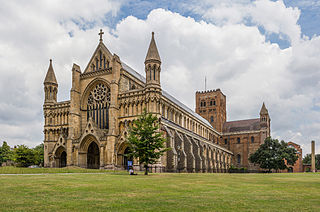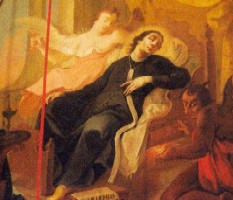
St Albans Cathedral, officially the Cathedral and Abbey Church of St Alban but often referred to locally as "the Abbey", is a Church of England cathedral in St Albans, England.

Matthew Paris, also known as Matthew of Paris, was an English Benedictine monk, chronicler, artist in illuminated manuscripts, and cartographer who was based at St Albans Abbey in Hertfordshire. He authored a number of historical works, many of which he scribed and illuminated himself, typically in drawings partly coloured with watercolour washes, sometimes called "tinted drawings". Some were written in Latin, others in Anglo-Norman or French verse. He is sometimes confused with the nonexistent Matthew of Westminster.
Thomas Walsingham was an English chronicler, and is the source of much of the knowledge of the reigns of Richard II, Henry IV, Henry V and the latter reign of Edward III depicting the decline of the state of affairs of the English. He also documented the careers of John Wycliff and Wat Tyler.
Roger of Wendover, probably a native of Wendover in Buckinghamshire, was an English chronicler of the 13th century.

The Flores Historiarum is the name of two different Latin chronicles by medieval English historians that were created in the 13th century, associated originally with the Abbey of St Albans.
Ranulf Higden or Higdon was an English chronicler and a Benedictine monk who wrote the Polychronicon, a Late Medieval magnum opus. Higden, who resided at the monastery of St. Werburgh in Chester, is believed to have been born in the West of England before taking his monastic vow at Benedictine Abbey in Chester in 1299. As a monk, he travelled throughout the North and Midlands of England, including Derbyshire, Shropshire and Lancashire.

Richard of Wallingford (1292–1336) was an English mathematician, astronomer, horologist, and cleric who made major contributions to astronomy and horology while serving as abbot of St Albans Abbey in Hertfordshire.

John of Wallingford, also known as John de Cella, was Abbot of St Albans Abbey in the English county of Hertfordshire from 1195 to his death in 1214. He was previously prior of Holy Trinity Priory at Wallingford in Berkshire, a cell of St Albans.
Wallingford Priory was a Benedictine priory dedicated to the Holy Trinity in Wallingford in the English county of Berkshire. Nothing remains of Holy Trinity Priory, which is believed to have stood on the site of the Bullcroft recreation ground off the High Street.
The Chronica Johannis de Oxenedes is a medieval chronicle written in Latin, probably around 1290.
Wallingford may refer to:
William of Wallingford was the 47th abbot of St Albans Abbey. He was a Benedictine monk at Holy Trinity Priory, Wallingford, Berkshire, England and like John of Wallingford and Richard of Wallingford, moved from this cell of St Albans Abbey to the abbey itself. He was a favourite of John Stoke, 44th abbot of St Albans, also from Wallingford. On his deathbed in 1451, Stoke was supposed to have given William and Thomas Wallingford, his senior chaplain, charge over 1000 marks but after his death they could only account for 250 marks. The abbot John Wheathampstead who succeeded Stoke suspected the two over the money. Nevertheless, William of Wallingford was later appointed abbot in 1476, after the death of William Albone, apparently for his financial acumen, at a time when the abbey was in debt. William of Wallingford managed to get rid of the debt whilst also spending on the abbey. He built the high altar known as the Wallingford Screen at a cost of £733 and completed the chapter house. The statues on it were destroyed during the Dissolution but were replaced in Victorian times.

William of Æbelholt was a French-born churchman of Denmark.
Rodulfus, was an 11th-century Benedictine chronicler.

Thomas Gale was an English classical scholar, antiquarian and cleric.

The Chronica Majora is the seminal work of Matthew Paris, a member of the English Benedictine community of St Albans and long-celebrated historian. The work begins with Creation and contains annals down to the year of Paris' death of 1259. The Chronica has long been considered a contemporary attempt to present a universal history of the world.
John of Wallingford may refer to:
John Westwyk was an English astronomer, adventurer, Benedictine monk, and author of the Equatorie of the Planetis.
John de Caleto, or John de Caux, born in Normandy, was Abbot of Peterborough Abbey and Treasurer of England.

The Historia compendiosa de regibus Britonum is an anonymous Latin history of Britain from the legendary arrival of Brutus of Troy until AD 689. It was written in England in the 13th or 14th century and survives in two early 14th-century manuscripts in the British Library: Arundel 220 and Cotton Julius D.vi.










